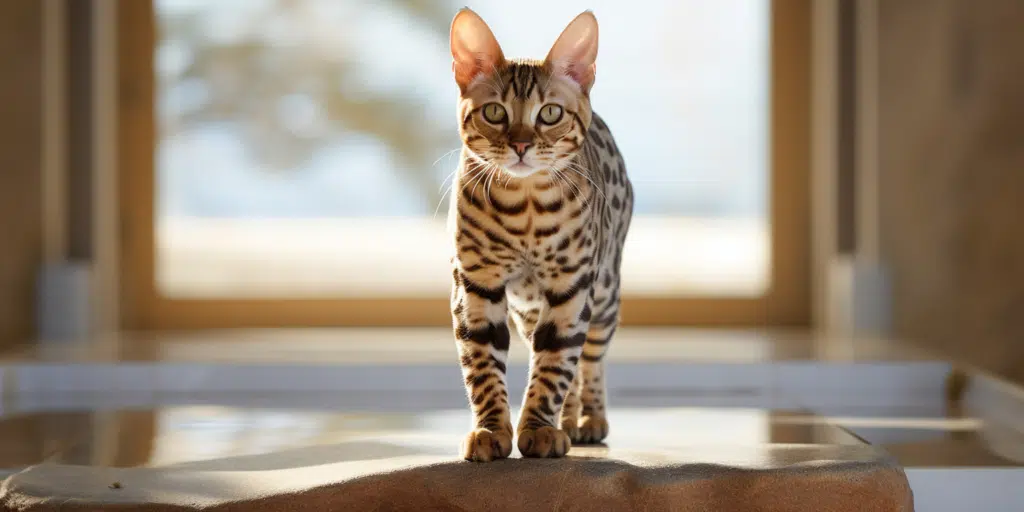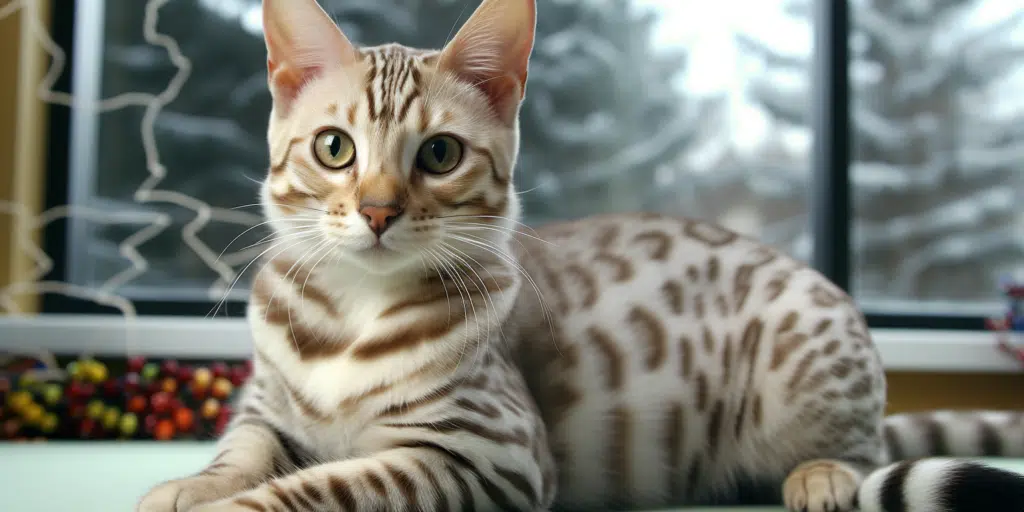When it comes to choosing a Bengal cat, understanding the differences between a male and a female is important for prospective owners. The distinction between Male vs. Female Bengal Cats can influence not only the physical characteristics but also the behavior and care requirements of these exquisite felines.
In this comprehensive blog, we explore the nuances that differentiate male Bengal cats from their female counterparts, touching on everything from physical attributes to temperament.
Bengal cats are known for their striking appearance and dynamic personalities. They have a wild look, reminiscent of their Asian leopard cat ancestors, and are highly sought after for their vibrant coats and patterns.
When deciding between Male vs. Female Bengal Cats, potential cat owners must consider various factors such as size, lifespan, grooming needs, and compatibility with children or other pets.
By understanding these differences, you’ll be better equipped to make an informed decision about which gender may be the best match for your home and lifestyle.

Visual Differences
| Male Bengal Cat | Female Bengal Cat | |
|---|---|---|
| Average height (adult): | 10-14 inches | 9-13 inches |
| Average weight (adult): | 10-15 pounds | 6-12 pounds |
| Lifespan: | 12-16 years | 12-16 years |
| Exercise: | High | High |
| Grooming needs: | Moderate | Moderate |
| Family-friendly: | Yes | Yes |
| Other pet-friendly: | Varies (socialization is key) | Varies (socialization is key) |
| Trainability: | High | High |
Male Bengal Cat Overview
Male Bengal cats tend to be more robust and larger compared to females. Their imposing stature often translates into a commanding presence that stands out even among other breeds. They are muscular and athletic, which is highlighted in their movements and playtime behavior. Males can also be territorial, which might be more noticeable than females, especially if they haven’t been neutered.
In terms of personality, male Bengals are often described as more outgoing and adventurous. They enjoy exploring their surroundings and can be more insistent on engaging in play or interactive activities with their human companions. This is not to say that male Bengals are without their moments of affection; many owners report that their male Bengals are very loving and will form strong bonds with family members.
Male Bengals may also exhibit more dominance-related behaviors such as marking territory or trying to assert themselves within the household hierarchy. This can sometimes make introductions to other pets more challenging. However, with proper socialization from a young age, males can live harmoniously with other animals and be integral parts of multi-pet households.
Training A Male Bengal Cat
Training a male Bengal cat requires consistency, patience, and positive reinforcement. Due to their intelligence and active nature, Bengals respond well to training that stimulates both their minds and bodies. Males may exhibit a more pronounced level of energy which makes them eager participants in training exercises but also means they can easily become bored with repetition.
Interactive toys, clicker training, and agility courses are excellent ways to keep them engaged while teaching commands or tricks. Additionally, crate training and structured playtimes can help manage some of the more exuberant behaviors males might display. It’s vital to establish leadership early on so that your male Bengal understands boundaries and appropriate behaviors within your home.
Health & Care for Male Bengal Cats
The health and care of a male Bengal cat largely align with general feline care but should always account for the breed’s specific needs. Regular veterinary check-ups are essential for monitoring health issues such as heart conditions or genetic disorders like progressive retinal atrophy (PRA), which Bengals can be predisposed to.
A high-quality diet rich in proteins helps maintain their muscular physique while regular exercise keeps them fit mentally and physically. Grooming should not be overlooked as even though Bengals have short hair, males can still benefit from frequent brushing to reduce shedding and prevent hairballs.
Suitable Environment for Male Bengal Cats
A suitable environment for a male Bengal cat includes ample space where they can climb, sprint, and explore safely; therefore, a home with room to roam is ideal. Providing vertical space through cat trees or shelves adds dimension to their territory and allows them to observe from high vantage points – something Bengals greatly enjoy.
Enrichment toys that stimulate hunting instincts can minimize potential destructiveness due to boredom. Since some male Bengals might exhibit territorial behavior, homes without other male cats might witness fewer conflicts if proper socialization hasn’t been established.

Female Bengal Cat Overview
Female Bengal cats are usually smaller in size than males but share the same energetic spirit characteristic of the breed. They have sleek physiques which allow them remarkable agility and elegance in their movements. Females might not appear as visually imposing but they can certainly match males in terms of playful vivacity.
The temperament of female Bengals often leans towards independence. They tend to be more calculated in their endeavors and interactions with humans or other pets. While they still bond deeply with family members, females may be selective about when they seek affection or playtime.
In households that already have pets, females might integrate more smoothly if introduced properly; however, just like males, each female has her unique personality traits so experiences can vary significantly from one individual to another.
Training A Female Bengal Cat
Training a female Bengal cat involves understanding her independent nature while also taking advantage of her quick learning ability. Females may prefer shorter training sessions that are regularly varied to combat potential disinterest.
Their nimble minds require engaging challenges so incorporating puzzle feeders or toys into training routines can help maintain focus. Positive reinforcement with verbal praise or treats promotes desired behaviors without damaging the trainer-patient relationship.
Health & Care for Female Bengal Cats
The health care routine for a female Bengal cat closely mirrors that of the male with particular consideration for reproductive health if she is not spayed. Spaying not only helps avoid unwanted litter but also reduces the risk of uterine infections and certain types of cancers.
Beyond reproductive health, keeping up with immunizations and preventive flea or tick treatments remains fundamental. A balanced diet tailored to her slightly smaller size may be necessary along with regular activities that satisfy her instinctual need for movement.
Suitable Environment for Female Bengal Cats
Given her spirited yet independent streak, the suitable environment for a female Bengal requires stimulation combined with cozy retreats where she can have solitary downtime when desired. Safe outdoor access via secured enclosures can satisfy her exploratory instincts while keeping her out of harm’s way.
Homes with existing pets may find facilitating initial interactions easier because females often display less aggression toward newcomers once they’ve been properly introduced.

Which One Is Right for You?
Deciding between a male vs. female Bengal cat truly depends on personal preferences and living situations. If you’re seeking an assertive companion who embraces the spotlight with zeal, a male might suit you best. For those looking for an agile yet somewhat independent pet, a female could be a better fit.
Consideration should also be given to how much time you’re able to dedicate to interactive play sessions and emotional enrichment within your daily routine; both genders require attention but in different forms based on individual personality traits.
Conclusion
Comparing Male vs. Female Bengal Cats reveals subtle yet meaningful variations in size, temperament, and care needs. Both genders bring unique qualities to the table—whether it’s the striking physical presence of males or the graceful independence of females.
Choosing between them should balance these characteristics against your lifestyle preferences ensuring an optimal fit between you and your new feline friend regardless of their gender. Remember too that each cat is an individual whose personality impacts how well they integrate into your life just as much as their gender does.